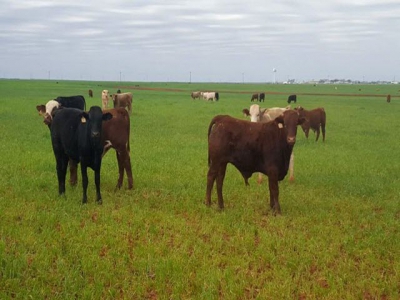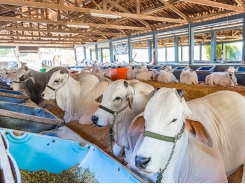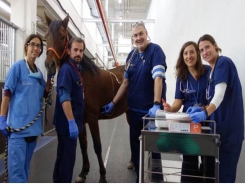New computer model helps producers predict wheat forage success

Model can simulate thousands of scenarios in minutes or hours compared to decades of field trials.
Winter wheat is an important forage crop for Texas beef cattle producers. A new DSSAT crop model created by researchers at the Texas A&M AgriLife Research & Extension Center will allow researchers around the world simulate biomass production to help producers make science-based decisions regarding winter wheat forage growth. (Texas A&M AgriLife photo by Dr. Jourdan Bell)
A new, pioneering forage wheat model could provide a valuable technique to researchers exploring the potential of biomass production for cool-season annual forage grasses, according to model developers.
Researchers at the Texas A&M AgriLife Research & Extension Center in Overton, Texas — Dr. Monte Rouquette, Texas A&M AgriLife Research plant physiologist, and Dr. Prem Woli, AgriLife Research crop modeler — recently published a paper in Agronomy Journal titled “Simulating Winter Wheat Forage Production in the Southern U.S. Using a Forage Wheat Model.”
The paper focuses on annual forage grass modeling with the "Decision Support System for Agrotechnology Transfer" (DSSAT), suite of crop computer models. Research by Drs. Charles Long, AgriLife Research animal breeder and center director; Ray Smith, AgriLife Research plant breeder and Lloyd Nelson, AgriLife Research plant breeder and professor emeritus also contributed to the publication.
“This model using DSSAT provides an application of decades of field data from Texas A&M AgriLife Research at Overton to be used to guide future decisions on forage wheat production,” Long said. “Simulating alternative outcomes for forage wheat production management options will ultimately aid producers in making decisions.”
DSSAT is a software application program that comprises dynamic crop growth simulation models for more than 40 crops, according to the DSSAT website. The program is supported by a range of utilities and applications for weather, soil, genetics, crop management and observational experimental data. It also includes example data sets for all the crop models included in the suite, the announcement said.
Crop simulation models, including the forage wheat model, simulate growth, development and biomass production as a function of the soil-plant-atmosphere dynamics and management.
The soil-plant-atmosphere system comprises environmental factors such as soil type, weather — temperatures, solar radiation, wind and precipitation — and production management variables including cultivars, planting/harvesting dates and inputs such as nitrogen fertilizer, Rouquette said.
Like other crop models, the forage wheat model may be used by researchers, educators or students to understand the mechanisms underlying forage wheat biomass production — or by growers or extension agents as a tool for optimizing forage wheat production, Woli said. Users can analyze “what-if” scenarios by manipulating the various factors that impact biomass production.
“The techniques and algorithms used while developing this model may be tremendously useful to other researchers interested in this field,” he said. “That is a significant contribution to annual forage grass modeling. A first annual forage grass model has been incorporated into the DSSAT suite.”
Over eight months, Woli input an incredible amount of data and calibrated the model parameters for evaluation. Woli “tinkered” with the equations and codes to create the new DSSAT forage model, Rouquette said.
Rouquette said around 30 growing seasons of winter wheat forage trial results data and 74 years of weather data from Overton and Henderson, Texas, were used to calibrate and evaluate the forage wheat model.
“We have a lot of history of small grain plantings for forage from Dr. Nelson’s variety trials here in Overton,” Rouquette said. “The field data ensure simulations are accurate and verifiable based on realistic conditions producers face season to season.”
The forage wheat model was used by the researchers to study winter wheat biomass responses to nitrogen, as influenced by two soil types. One was Lilbert, a sandy loam soil with more organic matter and water-holding capacity. Another was Darco, a sandy soil with low organic matter and water-holding capacity. Three planting dates were set between September and December and the ENSO — El Niño, La Niña and neutral — weather patterns, Woli said.
“By changing production factors, a model can simulate thousands of scenarios in minutes or hours compared to decades of field trials,” he said. “This is significant for forage production because it tells us what the variabilities mean in the form of biomass for livestock. It’s significant to researchers because until now we have only had the option of knowing what the outcome was under natural climate conditions each growing season.”
Of the various factors studied, Rouquette said nitrogen played the most important role in biomass production.
“If you’re not fertilizing in the southern U.S., you’re not growing,” he said. “The ENSO was not a significant factor for winter wheat forage production in this region because wheat is drought tolerant and a cool-season forage that isn’t very susceptible to drought.”
For instance, the simulation results showed winter wheat biomass was optimized at 120 lb. of nitrogen fertilizer per acre on the Lilbert soil, whereas the Darco soil required 240 lb. of nitrogen per acre, Rouquette said.
Rouquette said the research was focused on modeling winter wheat forage production for various scenarios without consideration of whether management calibrations, such as nitrogen and irrigation, were cost-effective or prohibitive. However, he noted, forage modeling with market conditions and input cost calibrations also considered could be possible in the future to help guide producer decision-making from season to season.
Woli and Rouquette said they are excited about the model and its continued application and improvement within the global DSSAT community, which includes thousands of scientists from more than 160 countries involved in modeling for a wide range of crops.
“You have to know something about the soil type, its fertility, the typical water availability and temperature when growing anything from winter wheat to tomatoes and pecans,” Woli said. “Those are the controlling factors. The model simulations let us look at the efficiency of all the factors while trying to maximize the biomass of forage winter wheat, but we hope to expand their use to other forage crops with other calibrations.”
Có thể bạn quan tâm
Phần mềm

Phối trộn thức ăn chăn nuôi

Pha dung dịch thủy canh

Định mức cho tôm ăn

Phối trộn phân bón NPK

Xác định tỷ lệ tôm sống

Chuyển đổi đơn vị phân bón

Xác định công suất sục khí

Chuyển đổi đơn vị tôm

Tính diện tích nhà kính

Tính thể tích ao hồ




 Study to take 'new approach' to mastitis
Study to take 'new approach' to mastitis  Dairy system model to examine complete production cycle
Dairy system model to examine complete production cycle